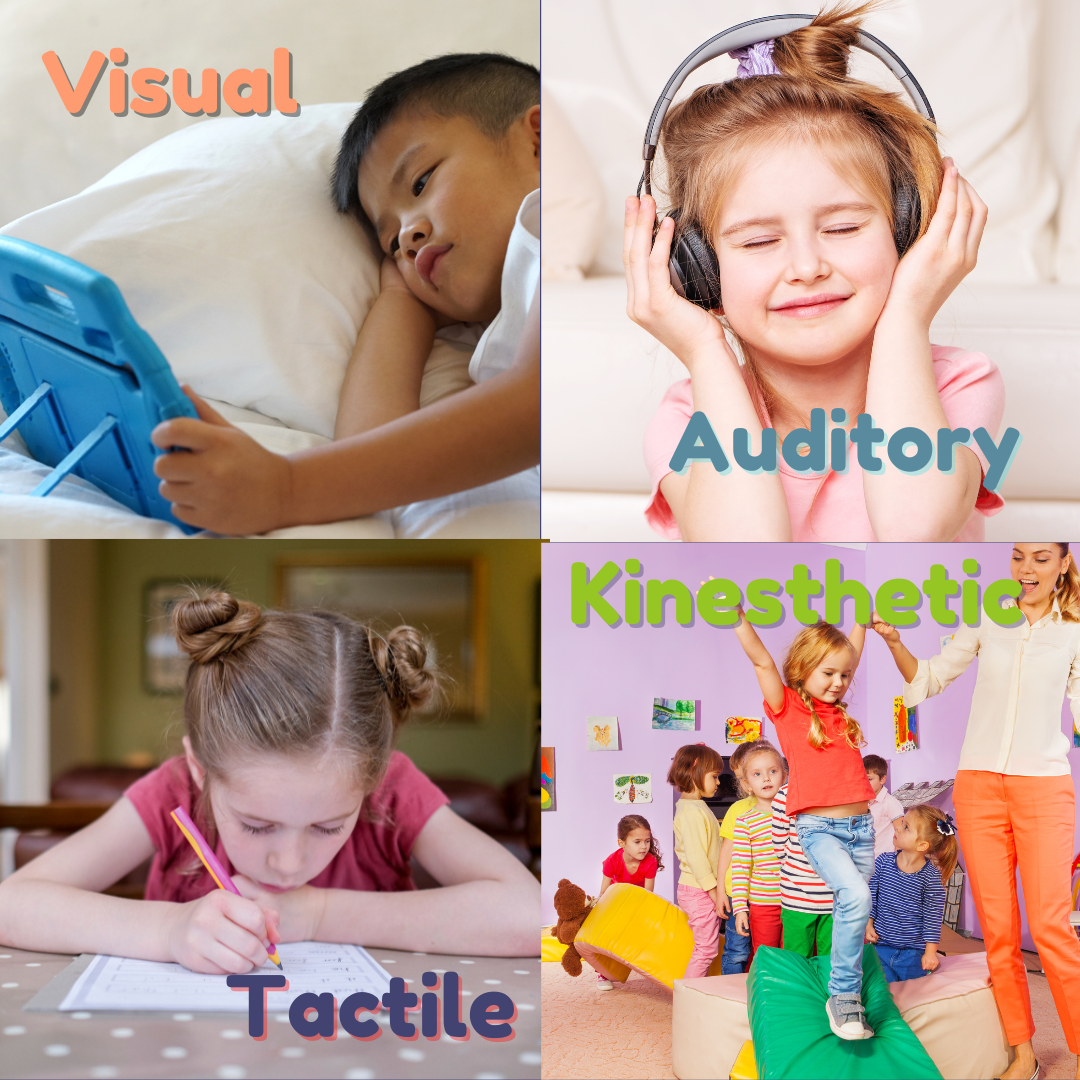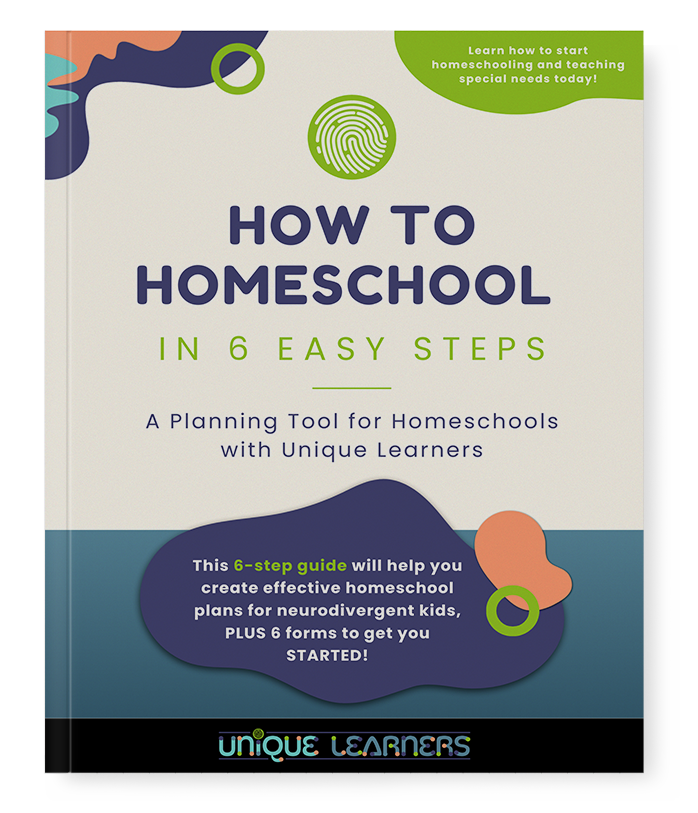VATK is a popular term that refers to how kids bring information into the brain when they are learning. There is a difference between using Learning Styles and Multisensory Learning in a homeschool environment. VATK is an important feature of both Learning Styles and Multisensory Learning, but the teaching is slightly different. In order to know the difference in Learning Styles vs Multisensory, we will cover a brief history of how the approaches have developed and changed and what that means for homeschooling in the 21st century.
Teach the Way They Learn
The idea of finding out your child’s Learning Style has been a popular idea in homeschooling for several decades. The Way They Learn, by Cynthia Ulrich Tobias, has been a best-selling homeschool book for many years. The book goes into learning style theory following VATK in a homeschool environment and has helped homeschool families understand the input modalities involved in learning. However, basing a homeschool on learning styles for kids with special needs is an outdated practice because we know so much more about how the brain processes and stores information.
Learning styles are actually learning preferences.
We all have preferences about the ways we like to do learning tasks. A child with special needs tends to have limited preferences that can actually make learning basic skills more difficult.
There have been several popular approaches to identifying learning styles: Dunn and Dunn, Gregorc Mind Styles, Renzulli and Smith’s Input Modalities, and Gardner’s Multiple Intelligences. Each of these learning styles theories looks at environment, input, processing, and output in the learning process. Each one has contributed to our understanding about how learning can be more effective. In this article, I will give a summary of these four theories of learning styles, how they can be useful in a homeschool, and the current, better way to look at how children can learn more effectively.
Environmental Input Matters
First, Dunn and Dunn (1975) looked at various elements that impact learning. The elements are divided into categories of stimuli (input). The categories are: Environmental, Emotional, Sociological, Physiological, and Psychological. Interestingly, these categories coincide with developmental domains, so they may actually change as a learner moves through different stages of growth. In reality, these elements all represent a child’s preferences, much of which cannot be accommodated in a classroom environment. Printing out the graphic may help in determining your child’s preferences. There is a long inventory created by Dunn and Dunn; however, I have found that just asking a child their choices based on the graphic is just as effective and takes much less time. Then we can adjust to the child quite easily in a homeschool environment.
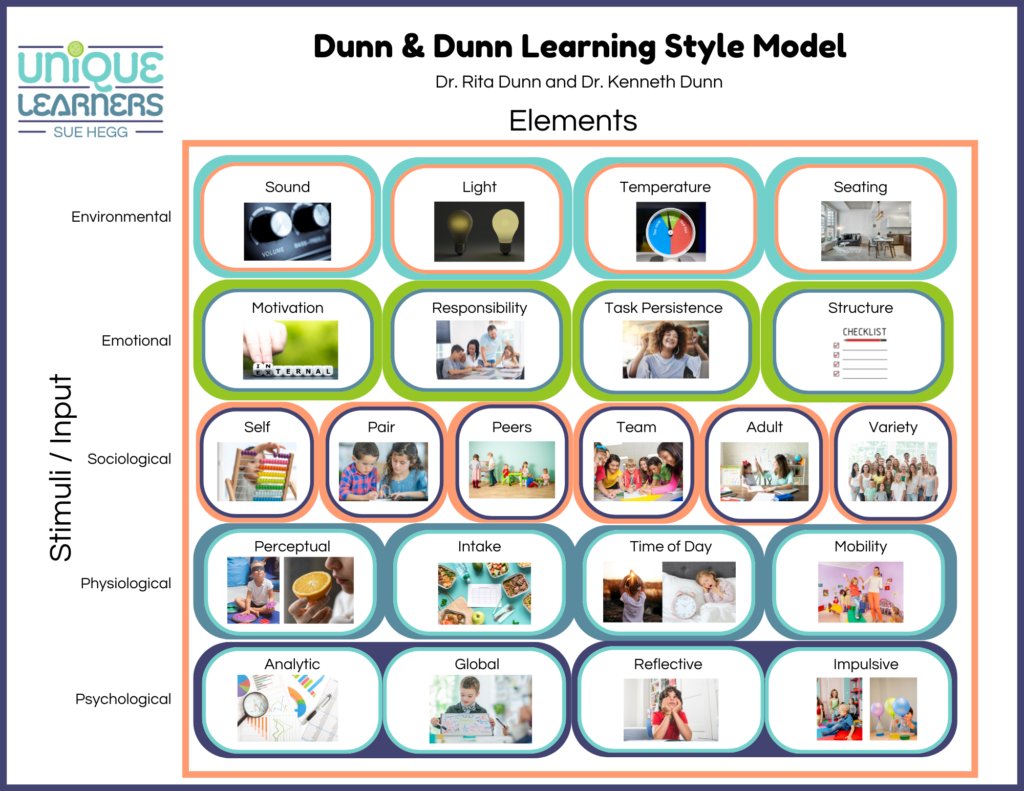
Processing and Thinking Styles
Next, Gregorc (1977) came up with a Mind Styles Model that took into consideration the differences between brain hemispheres and styles of language processing and logical thinking. Gregorc’s model is divided into 4 squares combining characteristics of a person’s processing. Concrete vs. Abstract looks at how a person perceives new information and logically problem solves. Sequential vs. Random looks at how a person organizes information. Together, a learner’s profile can supposedly explain the way that person functions in all areas of life, but especially in learning new academic material.
Personally, I think that a child’s personality and parenting styles influence the approach a child takes in problem solving. Current research in brain-based learning goes into much more specific detail about how a person takes information in and stores learned skills and material. While useful for its time, Gregorc’s model isn’t a very helpful model for homeschooling a child with special learning needs in today’s world.
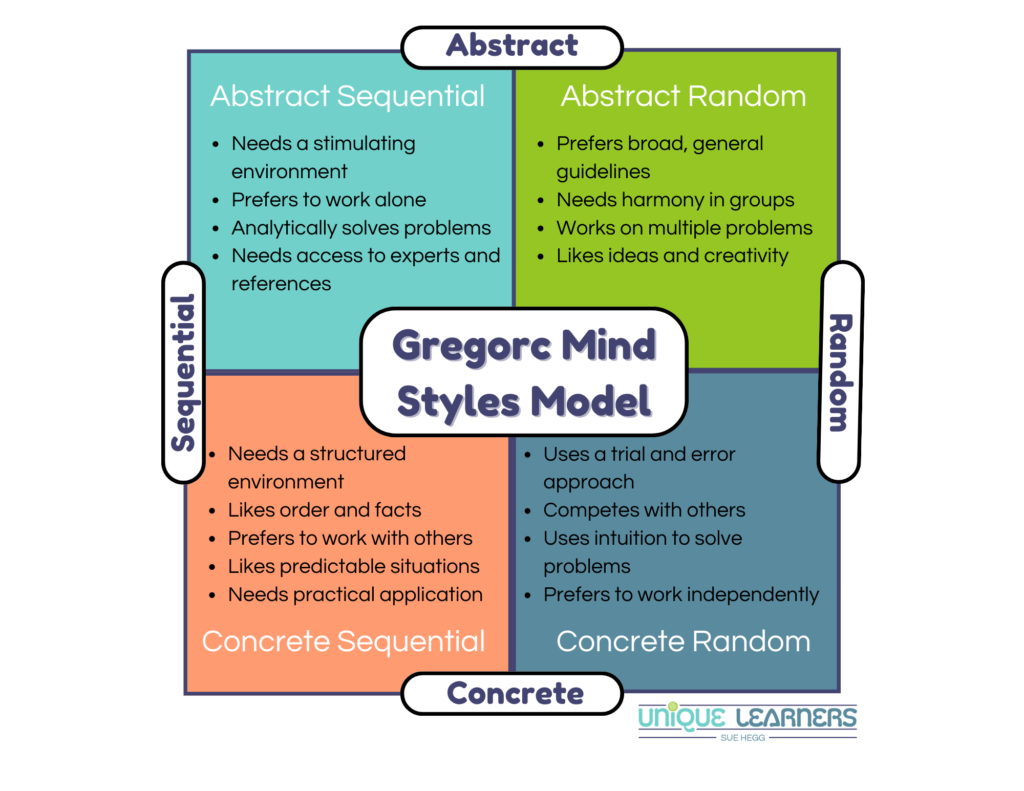
VATK = Visual – Auditory – Tactile – Kinesthetic
Renzulli and Smith (1978) tried to match input or sensory modalities to teaching styles. The input modalities are Visual, Auditory, Tactile, Kinesthetic (VATK). These are the sensory systems where we take information into our brains. It was assumed that learners have a preference for the way they take in information.
Thus, a visual learner is assumed to prefer seeing graphic images, pictures, videos, or read information. An auditory learner prefers to hear lectures, listen to podcasts, etc. This has been a cause of confusion for parents of a child with dyslexia. Dyslexia is primarily a deficit in auditory processing, yet frequently, kids with dyslexia prefer to listen to audiobooks or radio stories. This is an issue for another blog article, but for now, rest assured there is not a paradox in this phenomenon. A tactile learner prefers to take notes, draw pictures, or feel sensory textures with hands to store information. A kinesthetic learner remembers information best by running, riding a stationary bike, crawling, or being outdoors. Children with ADHD often are assumed to be kinesthetic learners; however, all children learn best if an activity includes movement of large muscles.
Renzulli and Smith thought that there was some benefit to the learner by matching how material is presented with a student’s preferred modality or stronger way of processing. While we know that VATK is still the four main ways we take in information, we now know that multisensory learning experiences help to store information into memory in more brain areas than trying to teach only to a child’s strengths. This is especially true for students with special learning needs.
Multisensory learning activities mean multiple senses used simultaneously while practicing a skill or learning content. The more senses used at the same time, the more places in the brain the information is stored. The more places information is stored assists in recall when that information is needed for use in daily life.
A more recent version of the input modalities model is VARK, which stands for Visual, Auditory, Reading/Writing, Kinesthetic. This is not really a necessary change when reading is primarily a visual/auditory task and writing is primarily a tactile recall task rather than an input modality.
We need to keep VATK input in mind but separating our instruction into a single input to accommodate a preference is not as effective as multisensory learning activities.
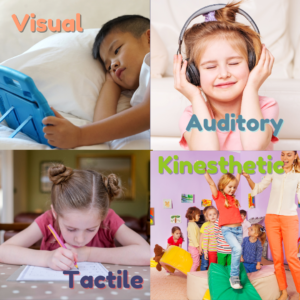
Gardner’s Multiple Intelligences Theory
Gardner’s (1983) Multiple Intelligences Theory isn’t really a learning styles theory. However, it acknowledges that everyone has strengths in brain processes that may not represent academic knowledge. Many times when a learner struggles in reading, writing, or math that same person may have a unique gift in a very specific area. This is especially true for students with dyslexia, who often show amazing giftedness in music, art, sports, culinary arts, mechanics, interpersonal skills, and more. Using multiple intelligences as a guide for planning learning experiences can help a teacher ensure that all students can demonstrate their learning by providing many options for output forms.
Many of the ideas for multisensory teaching and learning are easier to implement in a flexible homeschool environment than in a cookie-cutter, standards-based, curriculum-driven classroom. In fact, this was the model for effective, brain-based instruction that drew me to homeschooling way back in the 1990s! I had been taking graduate courses in multiple intelligences, and decided that the principles were very difficult to accomplish in a classroom environment that focused on grade levels and grading. I was teaching in a multi-age classroom of kids with special needs, so we had a lot of fun implementing multiple intelligences activities in our unit studies for social studies and science. Long before we even had kids, I decided that I wanted the flexibility to teach the way our kids learn and homeschooling was the best environment to accomplish that goal. I never looked back! Homeschooling has been a delightful way to do learning.
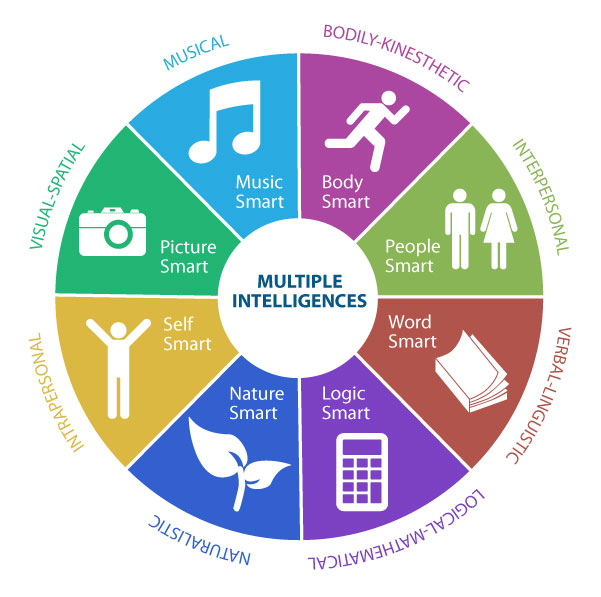
What does all this history have to do with homeschooling today?
So that brings us to the 21st century. Our understanding of learning and the brain comes out of neuroscience research and cognitive psychology. We know more about how the brain takes in, processes information, develops skills, and stores knowledge. We know that we bring information into the brain through all of our senses, not just VATK. Experts are not in agreement, but there are somewhere between 13 and 21 senses! For a list of senses, check out the reference list at the end. Brain-based learning using multisensory activities is much more effective than trying to identify an ambiguous learning style that is impossible to separate from other brain processes.
Cognitive training helps all learners, and especially unique learners!
Neurotypical brains have good communication between areas, organize information coming in, and store important knowledge efficiently from short-term to long-term memory. The abilities in a neurotypical brain allow learning to happen in nearly any environment with a variety of teaching styles, and a kid can learn regardless of their preferences. For kids with special learning needs, the brain glitches somewhere in that communication. The brain is so complex that narrowing our teaching to one or two preferred input modalities ignores how complex the brain is and can even hinder a child’s learning even more than whatever is causing the special learning need in the first place.
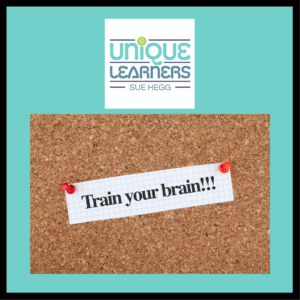
Learning happens best with multisensory activities, especially for students with any type of unique learning profile. Multisensory Learning means seeing something at the same time as hearing or speaking the information. When a learner then physically does something with that information by touching or moving, the information is stored in additional areas of the brain.
Here are two practical ideas you can try today!
1) Write one large word on an index card or whiteboard. Have your child look at the word and sound it out. With a rice tray, a sand tray, or play dough, have the child use fingers to write or build the word. Then have the child say the word aloud. This activates the visual processing system (occipital lobe/right hemisphere), the auditory processing system (temporal lobe/left hemisphere), and the tactile system (parietal lobe), as well as the connectors that communicate and synchronize different brain areas. And it’s fun!
2) Write between 5 to 10 math facts on index cards. Write the fact on one card and the answer on another. Scatter the cards around the living room or backyard. Dictate a fact to your child. Have the child run around the room or yard to collect the 2 cards that make the math sentence. The child should bring the cards to you, place them in front of you and say the whole math equation allowed. This time, the auditory processing system is activated first, kinesthetic (full body) movement activates many parts of the brain, finding the cards activates the frontal lobe (working memory), looking at the cards activates the visual processing system. Again, this is fun!
Rather than activating one or two brain processes by using a learning styles approach, multisensory instruction helps the brain to process and store information in at least 4 different places, as well as activate executive functions to help the learner work with the information and assist the different areas of the brain to work together. AND multisensory teaching is a lot easier and fun than trying to figure out a child’s preferred learning style!
Kids can become more efficient learners with technology-based cognitive training that helps the visual, auditory, movement, and thinking areas of the brain to synchronize. Cognitive training is a thinking skills form of learning that helps the brain process more accurately and efficiently. By having more synchronized brain processes, the child can more fully participate in instruction to that progress in academic skills and content information can make more progress in less time.
Finding the right cognitive training program is important to get the specific brain training that will actually enhance learning for your child. If you need help with cognitive training for your kiddo with special learning needs, feel free to contact Sue. Sometimes tweaking teaching methods to be systematic and multisensory is important. If you want to make your homeschool more effective for your special needs learner, check out our courses or schedule a consultation appointment with Sue.
If you want to read more:
Cherry, K. (2021). Gardner’s Theory of Multiple Intelligences.
Hiskey, D. (2019). Humans have a lot more than five senses – here are 18
Learning Abled Kids. (2022). Dunn and Dunn Learning Styles Inventory Model.
Orpi, D. (2022). What is Multisensory Learning and How to Implement Multisensory Teaching.
Peak Performance Center (2022). Gregorc Mind Styles Model.
